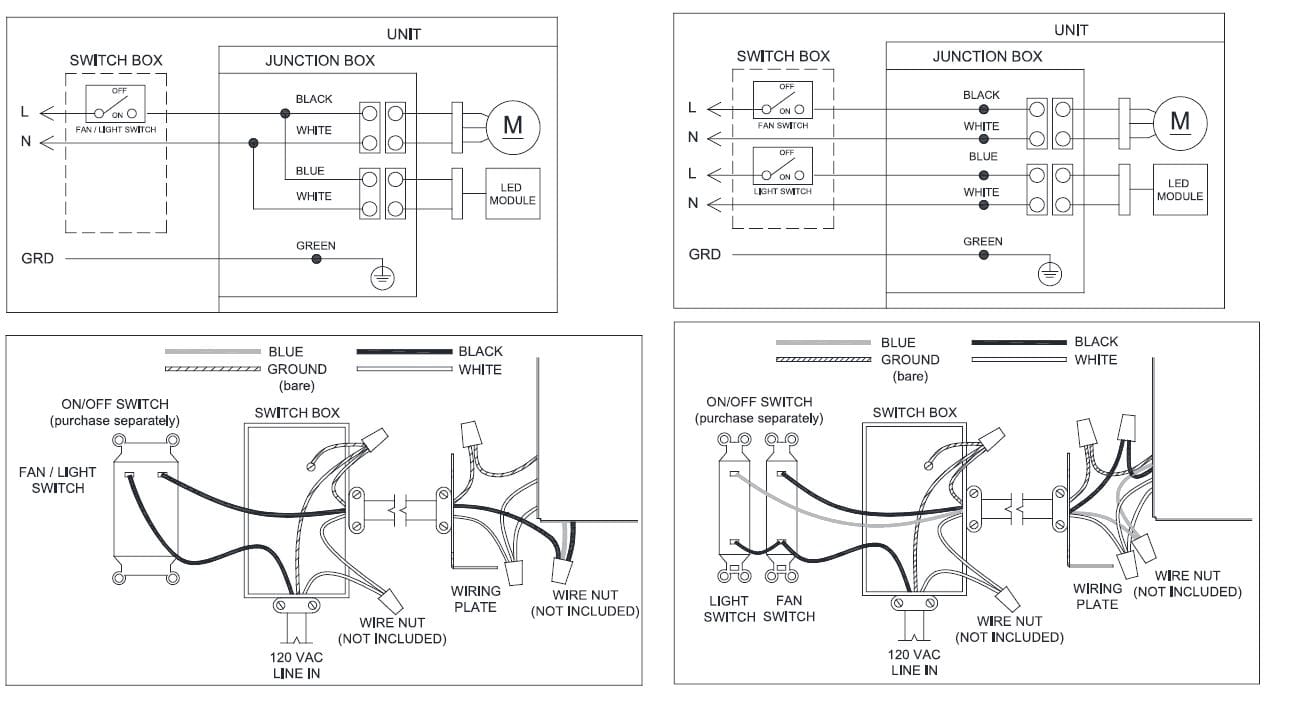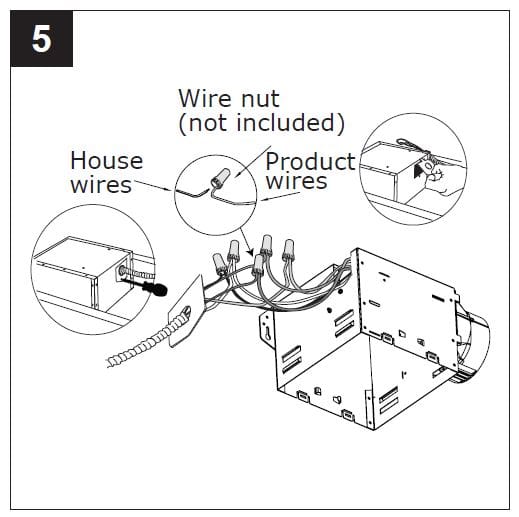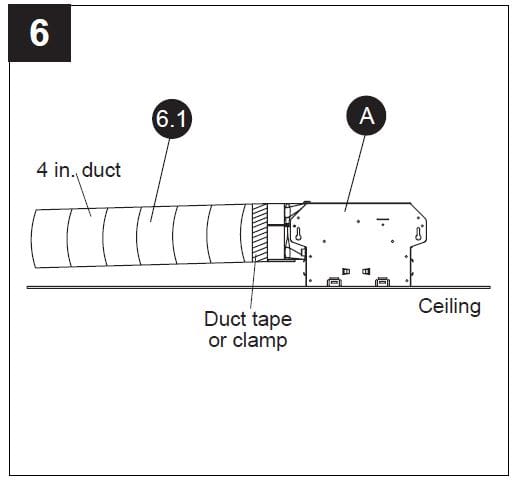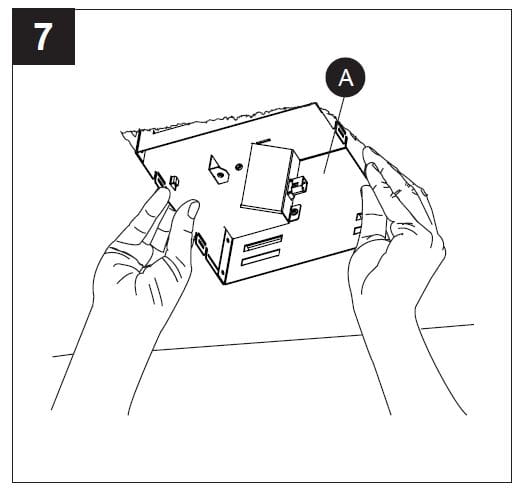
UtiliTech 7115-03 Ventilation Fan With LED Light
 PRODUCT SPECIFICATIONS
PRODUCT SPECIFICATIONS
| SPECIFICATIONS | SPECIFICATIONS | |
| Airflow: 100 CFM | Sound output: 1.5 Sones | |
| 120 V, 60 Hz | Power consumption: 30 W | |
| Duct diameter: 4 in. | Weight: 8.2 lbs. |
TYPICAL INSTALLATION

PACKAGE CONTENTS

| PART | DESCRIPTION | QUANTITY |
| A | Fan body | 1 |
| B | Grille | 1 |
| C | Duct connector | 1 |
SAFETY INFORMATION
READ AND SAVE THESE INSTRUCTIONS
Please read and understand this entire manual before attempting to assemble, operate, or install the product.
- Always disconnect the power supply before servicing the fan, motor, or junction box.
- Follow all local building, safety, and electrical codes, as well as NEC (National Electrical Code) and
OSHA (Occupational Safety and Health Act). - Electric service supply must be 120 volts, 60 hertz.
- This product must properly connect to the grounding conductor of the supply circuit.
- Do not bend or kink the power wires.
- Do not use this fan with a solid-state control device, such as a remote control or certain timers. Mechanical timers are not solid-state devices.
- Do not install in a ceiling with insulation greater than R40.
- Ductwork should be installed in a straight line with minimal bends.
- The ductwork size must be the same as the discharge and should not be reduced. Reducing the duct size may increase fan noise.
WARNING
TO REDUCE THE RISK OF FIRE, ELECTRIC SHOCK, OR INJURY TO PERSONS, OBSERVE THE FOLLOWING:
- Use this unit in the manner intended by the manufacturer. If you have any questions, please call customer service.
- Before servicing or cleaning the unit, switch the power off at the service panel and lock the service disconnecting means to prevent power from being switched on accidentally. When the service disconnecting means cannot be locked, securely fasten a prominent warning device, such as a tag,
to the service panel. - Installation work and electrical wiring must be performed by a qualified person(s) by all applicable codes and standards, including fire-rated construction requirements.
- Sufficient air is needed for proper combustion and exhausting of gases through the flue (chimney) of fuel-burning equipment to prevent backdrafting. Follow the heating equipment manufacturer’s guidelines and safety standards, such as those published by the National Fire Protection Association (NFPA), the American Society for Heating, Refrigeration and Air Conditioning Engineers (ASHRAE), and local code authorities.
- When cutting or drilling into the wall or ceiling, do not damage electrical wiring and other hidden utilities.
- Ducted fans must always be vented to the outdoors.
- If this unit is to be installed over a tub or shower, it must be marked as appropriate for the application and be connected to a GFCI (Ground Fault Circuit Interrupter) – protected branch circuit.
CAUTION
- For general ventilating use only. Do not use hazardous or explosive materials and vapors.
- Not for use in cooking areas.
- To reduce the risk of injury to persons, install the fan at least 8.2 feet (2.5m) above the floor.
PREPARATION
Before beginning assembly of the product, make sure all parts are present. Compare parts with the package contents list. If any part is missing or damaged, do not attempt to assemble the product.
- Estimated Assembly Time: 60 minutes
- Tools Required for Assembly (not included): Hammer, Flathead Screwdriver, Wood Screws, Nails, Duct Tape, Phillips Screwdriver, Utility Knife
- Helpful Tools (not included): Electric Drill, Drill Bits
- WARNING: Turn off the electricity at the breaker box before beginning installation.
- Carefully remove the unit from the carton.
- Check the area above the installation location to be sure that the wiring can run to the planned location, that ductwork can be run, and that the area is sufficient for proper ventilation.
- Inspect ductwork and wiring before proceeding with the installation.
- Before installation, provide inspection and future maintenance access at a location that will not interfere with installation work.
- You may need the help of a second person to install this fan: one person on the attic side and one on the room side.
Note: Installations may vary depending on how the previous bath fan was installed. Supplies necessary
for the installation of your bath fan are not all included; however, most are available at your local home improvement or hardware store.
DIMENSION REQUIREMENTS
| Ceiling Opening (L) | Ceiling Opening (W) | Ceiling Opening (H) |
| 7.5 in. | 7.25 in. | 5.75 in. |
WIRING DIAGRAM
- Single Switch Control – With a single switch, the fan and LED light can be turned on and off simultaneously.
- Dual Switch Control – With dual switches, the fan and LED light can be controlled independently.

NEW CONSTRUCTION ASSEMBLY INSTRUCTIONS
BEFORE the powerLLATION – Turnofff he ff pothe wer source. Review all safety precautions.
- Attach the duct connector (C) to the fan housing (A).

- Remove the wiring box cover (2.1) from the fan housing (A). Remove the wiring knockout (2.2) from the wiring box cover (2.1) with a flathead screwdriver (not included).

- Place the fan housing (A) next to a ceiling joist. The fan housing should be level and perpendicular to the joist.

- Mount the fan housing (A) to the ceiling joist using wood screws (4.1) (not included) where indicated.

- Pull the house wires through the wire box cover hole. Secure 120 V AC house wiring from the wall switch to the fan as shown in the wiring diagram on page 5. 14 AWG is the smallest conductor that should be used for branch-circuit wiring.
Carefully push the connected wires back into the wiring box housing. Reattach the wiring box cover.
CAUTION: If the electrical wires do not match the colors listed, you must determine what each house wire represents before connecting. You may need to consult an electrical contractor to determine it safely.

- Install a circular 4 in. duct (6.1) (not included) and secure it with duct tape or clamps (neither included). Finish ceiling work. The ceiling hole should be aligned with the edge of the fan housing (A).

- For the LED light connection, plug in the connector (7.1) from the grille (B) into the fan housing (A) as shown. Pinch the mounting springs (7.2) on the grille (B) and insert them into the narrow rectangular slots (7.3) inside the fan housing (A). Push the grille (B) up toward the ceiling.
EXISTING CONSTRUCTION ASSEMBLY INSTRUCTIONS
BEFORE INSTALLATION – Turn off the power source. Review all safety precautions. Remove the old fan.
- Measure the opening to ensure it is large enough to accommodate the new fan housing (A) (7.5 in. x 7.25 in.). If this fan is not replacing an old fan, be sure to cut a 7.5 in. x 7.25 in. opening for the fan housing (A).
MAKE SURE THE 7.25 IN. SIDE OF THE OPENING IS FLUSH WITH THE JOIST FOR INSTALLATION FROM BELOW.
- Attach the duct connector (C) to the fan housing (A).

- Remove the three screws (3.1) that hold the motor assembly (3.2) in place. Remove the fan motor
assembly (3.2) from the fan housing (A). Unplug the fan power unit (3.3).
- Remove the wiring box cover (4.1) from the fan housing (A). Remove the wiring knockout (4.2) from the wiring box cover (4.1) with a flathead screwdriver (not included).

- Pull the house wires through the wire box cover hole. Secure 120 V AC house wiring from the wall switch to the fan as shown in the wiring diagram on page 5. 14 AWG is the smallest conductor that should be used for branch-circuit wiring.
Carefully push the connected wires back into the wiring box housing. Reattach the wiring box cover.
CAUTION: If the electrical wires do not match the colors listed, you must determine what each house wire represents before connecting. You may need to consult an electrical contractor to determine it safely.
- Install a circular 4 in. duct (6.1) (not included) and secure it with duct tape or clamps (neither included). Finish ceiling work. The ceiling hole should be aligned with the edge of the fan housing (A).

- Insert the fan housing (A) through the existing hole in the ceiling. The fan housing (A) should be level and perpendicular to the joist.

- Mount the fan housing (A) to the ceiling joist using wood screws (8.1) (not included) where indicated by arrows inside the fan housing.

- Plug back in the power unit (9.1). Replace the motor assembly (9.2) into the fan housing (A) using the three screws (9.3) removed in step 3.

- For the LED light connection, plug in the connector (10.1) from the grille (B) into the fan housing (A) as shown. Pinch the mounting springs (10.2) on the grille (B) and insert them into the narrow rectangular slots (10.3) inside the fan housing (A). Push the grille (B) up toward the ceiling.
CARE AND MAINTENANCE
WARNING: Disconnect the power supply before servicing. See SAFETY INFORMATION before proceeding. Routine maintenance should be done at least once a year.
- Wash the grille with mild soap and water, and dry with a cloth.
- Remove excess dirt and dust from the fan housing with a vacuum cleaner.
- Do not use solvents, thinners, or harsh chemicals for cleaning the fan.
- Do not allow water to enter the motor.
- Do not immerse resin parts in water over 140º F.
TROUBLESHOOTING
| PROBLEM | POSSIBLE CAUSE | CORRECTIVE ACTION | |||||||||||||||||||||
|
The fan seems louder than it should | CFM too great | Be sure the CFM rating on the fan matches the size of your room | |||||||||||||||||||||
| The damperr is not working properly or is damaged | Check the damper to ensure it is opening and closing properly. If the damper has become damaged, please call Customer Service. | ||||||||||||||||||||||
| Bend in the duct too close to the fan discharge. | Be sure you do not have any sharp bends in the duct closer than 18 in. to the fan discharge. | ||||||||||||||||||||||
| Fan discharge reduced to fita smaller duct | Use recommended size ducting to reduce fan noise | ||||||||||||||||||||||
| The fan body is not securely attached | Be sure the fan is securely attached to your ceiling joists | ||||||||||||||||||||||
|
The fan is not clearing the room. |
Insufficient intake airflow within the room | Be sure a door or window is slightly ajar or open to allow airflow. The fan is not able to draw air out of the room without enough airflow to draw from | |||||||||||||||||||||
|
Insufficient CFM | Be sure the CFM rating on the fan matches the requirements for your room size. NOTE: Using a tissue is not an accurate method for determining if the fan is operating properly. If the fan clears steam from the room within approximately 15 minutes of completing your shower, then the fan is operating properly.
|
LIMITED 5-YEAR WARRANTY
If this product fails due to a defect in materials or workmanship at any time during the first FIVE years of ownership, the manufacturer will replace it free of charge, postage-paid at their option. This warranty does not cover products that have been abused, altered, damaged, misused, cut, or worn. This warranty does not cover use in commercial applications. Use only manufacturer-supplied genuine warranty, repair replacement parts to repair this fan. Use of non-genuine repair parts will void your warranty.
The manufacturer DISCLAIMS all other implied or express warranties, including all warranties of merchantability and/or fitness for a particular purpose. As some states do not allow exclusions or limitations on an implied warranty, the above exclusions and limitations may not apply. This warranty gives you specific legal rights, and you may have other rights that vary from state to state.
This warranty is limited to the replacement of defective parts only. Labor charges and/or damage incurred during installation, repair, and replacement, as well as incidental and consequential damages connected with the above, are excluded. Any damage to this product as a result of neglect, misuse, accident, improper installation, or use other than the purpose SHALL VOID THIS WARRANTY.
Shipping costs for return products as part of a claim on the warranty must be paid for by the customer.
Inquiries regarding warranty claims can be directed to 1-866-994-4148, 8 a.m. – 6 p.m. EST, Monday-Thursday a.m. – 5 p.m. EST, Friday.
For more manuals about UtiliTech, visit ManualsLibraryy


 PRODUCT SPECIFICATIONS
PRODUCT SPECIFICATIONS













